Inside the Sweeping, $30 Million Renovation of East Hampton’s Cultural Center, Guild Hall
- Oops!Something went wrong.Please try again later.
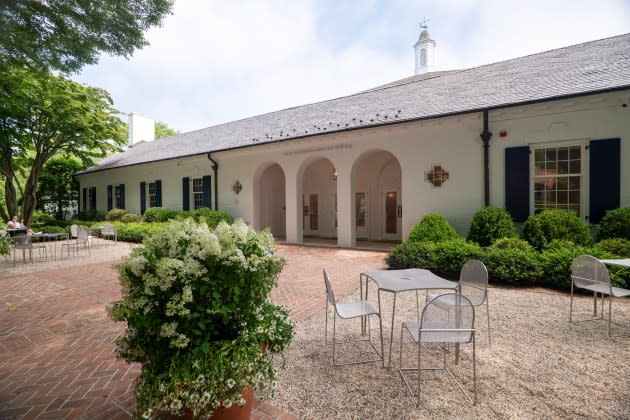
There’s a glorious past to Guild Hall, the 93-year-old regional cultural hub in East Hampton, N.Y., where Gwen Vernon created benefit dance festivals, Edward Albee directed theater in the 1970s, Thornton Wilder starred in his play “Our Town,” and which Willem De Kooning once referred to its members as “family.”
The summer seasons were headlined by the stars of the day, including Olivia de Haviland, Christopher Plummer, Geroge C. Scott, even Bela Lugosi in his defining “Dracula” role.
More from WWD
A Closer Look at the Parrish Art Museum's Summer 2024 Exhibitions
'Walk With Me: Hamptons' Captures the History, Quaint Homes and Dreamy Scenes of NYC's Summer Escape
Bonpoint Opens in East Hampton and The Maidstone Gets a 'Rejuvenated' Menu, Plus Openings Out East
Guild Hall did have its physical limitations, sometimes restricting what could be showcased. “We used to close the building to receive art, and the semis would back up to the front doors and try to unload works that barely fit through,” says Andrea Grover, executive director of Guild Hall, recalling the not-too-distant past. “The doors were 6-foot, 8-inches high, and 5-feet wide, like household doors.”
Now Guild Hall is nearing completion of a two-year, $30 million renovation, in a bold endeavor to raise awareness of the historic institution, broaden the scope of its programming and eradicate the drawbacks of its past.
The project is sweeping, touching just about all aspects of the 24,000-square-foot building and the 46,000-square-foot property at 158 Main Street. It’s involved overhauling the theater, the three gallery spaces, outdoor areas, entrances, lighting and adding amenities, such as a café.
An art handling section has been built and, of course, larger doors — 8 feet tall and 6 feet wide — have been installed. Wall space for display was added by removing unnecessary doors, cornices and trims. There’s new signage, bathrooms and an outdoor amphitheater.
There’s been a near total overhaul of Guild Hall’s infrastructure with new electrical, security and sprinkler systems; new windows; roof repairs, and new vapor barriers added to help preserve the art and the building itself. The possibilities for presenting innovative exhibits and performances have opened up, and efforts to engage with local communities such as the Shinnecock Nation, and younger audiences, have stepped up.
History and Functionality
Among the current exhibitions is the First Literature Project, through July 15. The project utilizes the new Apple Vision Pro headset for an immersive experience developed over two years by artists-in-residence Wunetu Wequai Tarrant and Christian Scheider featuring video works by the Shinnecock language revitalization collective Ayim Kutoowonk, and interviews with members of the Shinnecock Nation.
“We have not changed the footprint of the building. The scale and the historic character have been maintained, but we’ve made it beautiful and more functional for artists and performers. It’s nothing short of a total infrastructure replacement of an historic building,” Grover says. “And we’ve overcome a lot of the shortcomings that would naturally arise with a building that’s nine decades old.”
According to Guild Hall’s records, the institution was founded by Mary Woodhouse, a wealthy seasonal resident “with a passion for village preservation and improvement projects,” who donated land and $100,000. The name Guild Hall comes from the British guild halls used for civic and cultural purposes.
Guild Hall opened in August 1931, and throughout its history has continued to tap the unique concentration of musicians, dancers, playwrights, photographers, artists and Broadway and Hollywood actors and actresses who would summer or live year-round in the Hamptons, like Matthew Broderick, Alec Baldwin, Jackson Pollock, Lee Krasner, Kurt Vonnegut and Julian Schnabel, whose works will be on exhibit Aug. 3 through Oct. 28.
Back in the 1930s, theater and art was different and treated quite differently. As Grover explains, there were a lot of American Impressionism paintings that weren’t framed, and smaller works to display on walls. Now there are installations, paintings and photographs of more considerable dimension, requiring a different milieux for proper presentation.
“Today, when you meet an artist, the last thing you want to ask them is ‘Are you a painter?’ Because most artists don’t define themselves by one medium. They work across media and genres,” Grover says. “So Guild Hall is adapting to a generation of artists that’s much more interdisciplinary. There might be some theater in the galleries or we might have hybrid programming in the galleries.” Guild Hall’s renovation and redesign, she says, reflects that blending of artistic disciplines.

It’s a crisp, spring Saturday afternoon when Grover gives a guest a tour of the revitalized facility. She’s joined by Marty Cohen, chairman of the board of trustees of Guild Hall, and Lisa Schultz, who chairs Guild Hall’s marketing committee, serves on the executive committee at-large, and works closely with vice chairman Ken Wyse.
The Past and Future
“We’re going to take you into the future and the past,” says Grover, starting the tour, at the “Look Alive” space, which was organized by writer, artist and creative producer Ellie Duke. It’s devoted to young, emerging artists who live in the community, and represent the future. Every week a different artist has the space, like an artist-in-residence and, on this particular day, Kate Cavanaugh is here, leading workshops in natural dyeing of silk using eco printing. Just behind Cavanaugh is Harris Allen, another young artist who is creating video portraits.
Next, Grover leads the way to the main gallery, where “the past” on this day was represented by an exhibit of photographs of artists by other artists, called “A Creative Retreat: Portraits of Artists,” which closed May 6. Photos showed such luminaries as Alfred Stieglitz, Frank O’Hara, Marcel Duchamp, Duke Ellington, Nina Simone, Ralph Ellison, Robert Rauschenberg and Jasper Johns, among others, at cookouts on the beach or poolside in the Hamptons in the 1950s and ’60s. They all got involved in Guild Hall. Included were candid Polaroids shot by Abraham Rattner on a road trip to Louisiana with Henry Miller, who along that journey wrote “The Air-Conditioned Nightmare.”
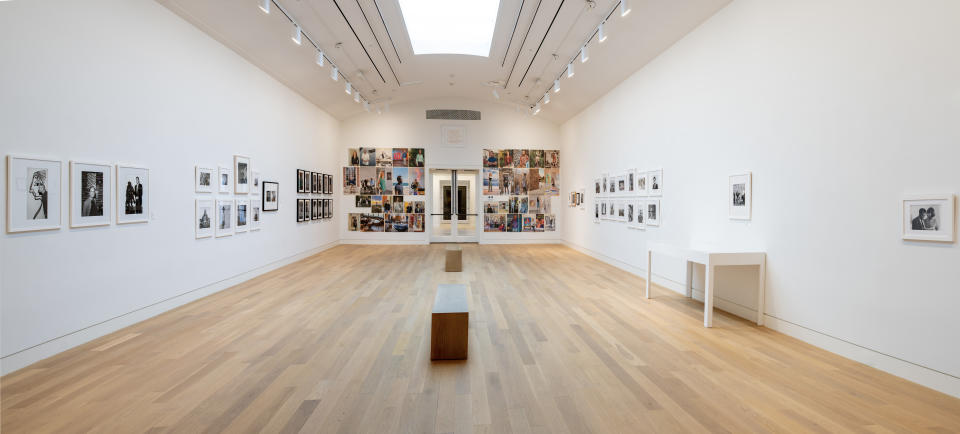
“Guild Hall was so artists-driven when it opened during the Great Depression and for three decades probably because there was no professional staff,” Grover says. “Artists and committees really put together the program and that’s what you saw when Gwen Verdon did a dance festival and Edward Albee directed the summer program in the theater.”
In the adjoining gallery space is an exhibit of mixed-media works by Darlene Charneco, a contemporary artist who lives and works on the East End of Long Island. “Because Guild Hall has a small footprint, we are decidedly not encyclopedic,” Grover says. “We focus on artists who have a connection to the region. The theater is open to anyone, from all over the world. But the museum focuses on artists of the region.”
Leading the way into the enlarged lobby, chairman Cohen says, “It felt very confining before. You’d have over 300 people coming to the theater and two thirds had to spill out onto the sidewalk or find any place they could stand.”
Peering outside, Cohen observes, “We’ve expanded the terrace. There are tables and chairs. Guild Hall no longer feels crowded. It’s a more welcoming place. People think about East Hampton as kind of elitist, but there are a lot of underserved families and we bring them here to really expose them to art and the community. Teens get together here. They’re socializing. In this world today there’s an epidemic of loneliness. This is a place where we can try to counter that.”
Cohen says that one of the first things he did in reimagining Guild Hall for the future was to purchase the house next door. “We call it the Guild House. The rationale was to have a house for artists or performers to stay overnight, and rent it as a meeting space. Before we had no real space where we could do this.”
Transformation
With the addition of the house, natural and manmade barriers separating it from Guild Hall were removed and outdoor areas for receptions, performances or just hanging out have been restored, transforming the setting. “It’s really looking like a campus,” Cohen says.
At the new art handling space, a greater variety of art can be received safely, and stored. It’s also where frames can be changed, and condition reports are made. “It’s secure,” Grover says. “Only the curatorial staff can enter the space. It makes us better stewards of art objects. We’re an accredited museum. We have been since 1973. That status is very hard to get.”
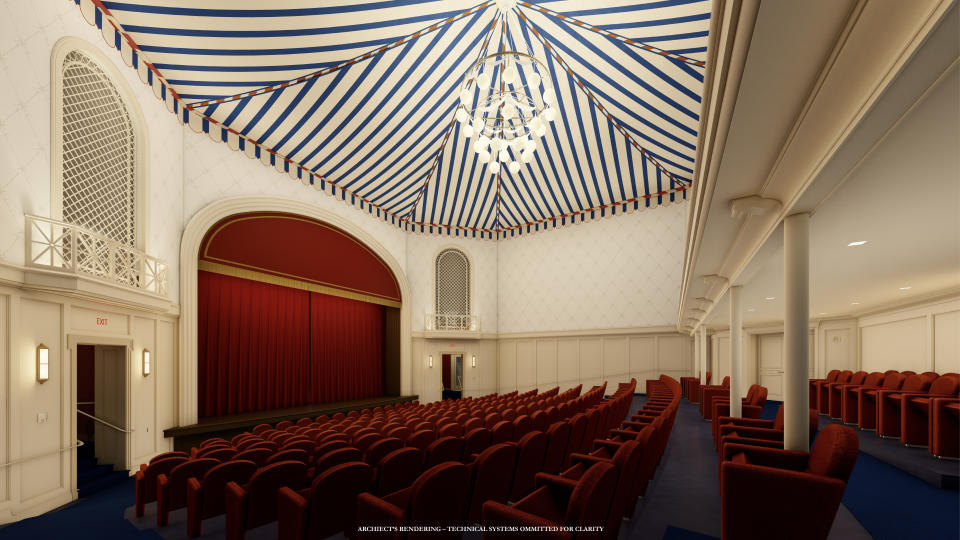
She leads the group to the John Drew Theater, named posthumously after the uncle of John, Ethel and Lionel Barrymore, the legendary family of actors. Drew summered in the Hamptons. The theater is still under construction and expected to be completed by July. Grover singles out the upgraded lighting, audio and video technology; the wider seats for greater comfort; the wider aisles so there’s less chance of bumping into those already seated as you find your seat, and the improved viewing so you can see above the head of the person in front of you. The center aisle was eliminated, capturing additional orchestra seating; the control booth was relocated upstairs, adding space and steps replaced the aisle slope, so people are less likely to trip finding their seats.
The plaster work on the ceiling, with its striking circus tent motif, has been restored, and two high-tech components were introduced: an audio lift system for electronic sound enhancement that can be regulated to the type of performance happening, and remote controlled cameras, for livestreaming or recording shows for replaying.
“We want to be able to present artists either on stage or in the gallery as they were intended to be presented — without limitations. The new technology in the theater allows us to do that, and then the expanded quality of the galleries allows us to hang bigger works and receive it better. We also put in a PA system in the gallery, so when we have tours or artist talks, you can hear throughout the space,” Grover says.
Among the upcoming shows, Billy Porter on July 12; the Branford Marsalis Quintet on July 17; the New York City Ballet on July 20, and “An Evening of Short Plays” directed by Bob Balaban, July 27 and July 28. Florence Fabricant will be “In Conversation” August 18 with Pam Weekes and Connie McDonald of Levain Bakery, and on Aug. 25 with Marcus Samuelson; Neil deGrasse Tyson will give a talk on Aug. 18.
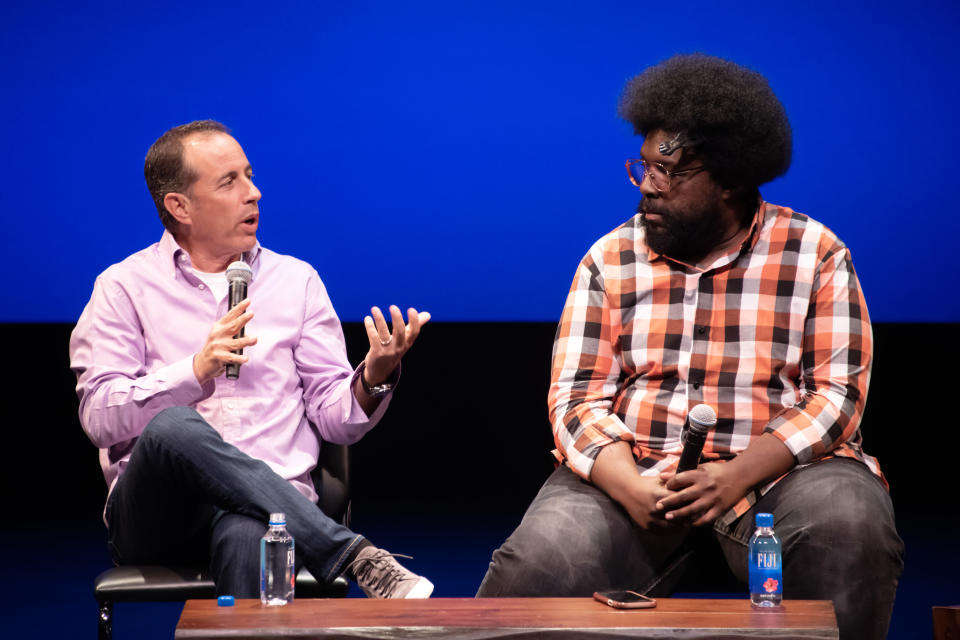
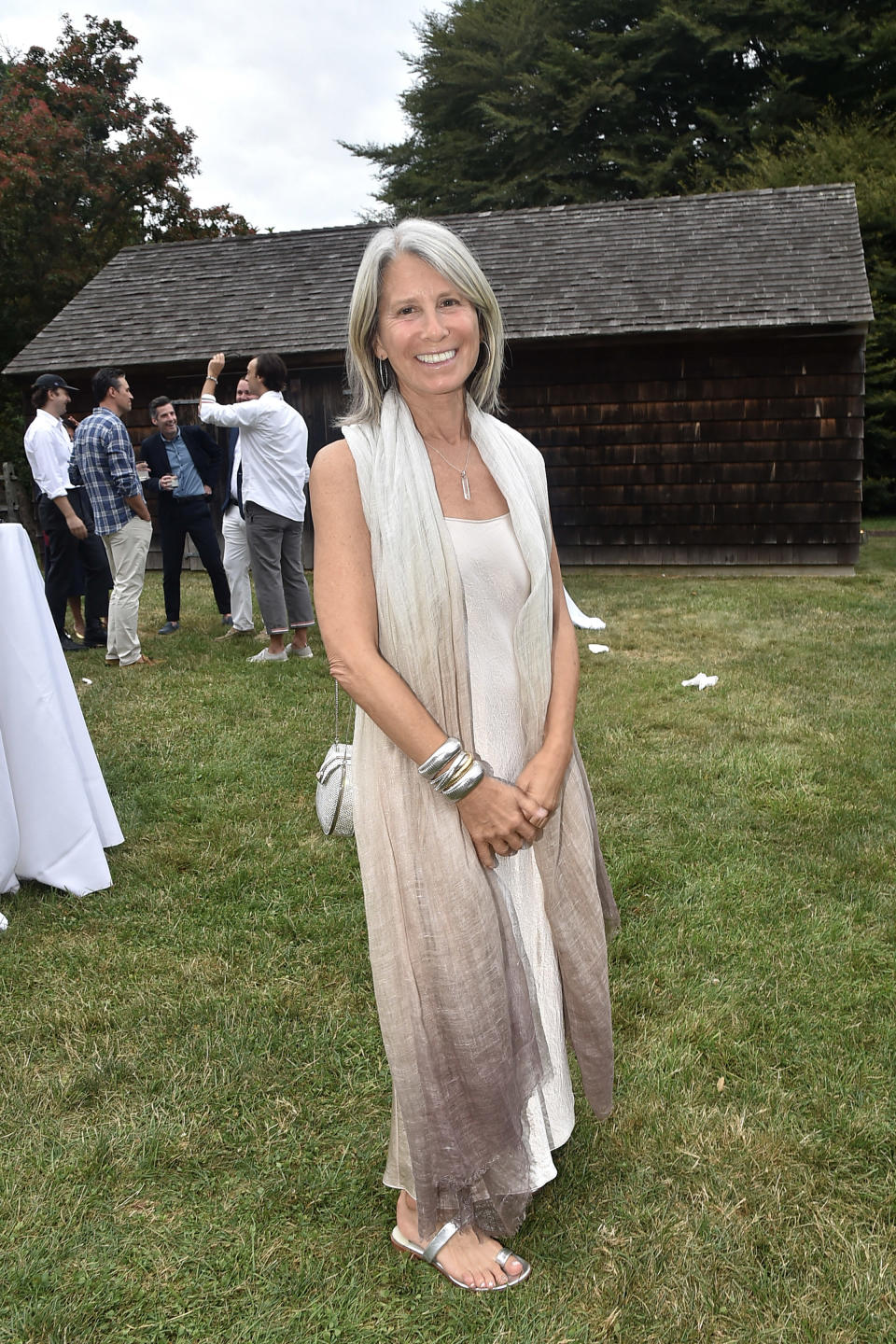
“This is a luxurious, state-of-the-art experience,” Schultz says. “It used to be people would come here, visit whatever, and leave. But people really don’t want to just see an exhibition. So here it’s now conducive to hanging around, enjoying the experience and then being part of the experience. It’s not so static. Instead of just saying what’s at the movie theater tonight, now people in the Hamptons are really asking, ‘what’s going on?’
“We have an edict here, a saying, ‘Let artists lead the way,'” Grover says. “So we very much built the renovation around the needs of today’s artists. I don’t say artists with a capital A. I say artists with a small a, which is everyone in the community who makes anything creative. We didn’t renovate just to renovate. We renovated to be more functional, accommodating and appealing to the artists and performers and their work, and everyone who uses or visits this building.
“Artists tend to see the future before the rest of us,” Grover adds. “They look around the corner, and that’s why a lot of institutions are incorporating artists into different departments and branches of knowledge because they push research further. They push questioning, critical thinking, all of that.
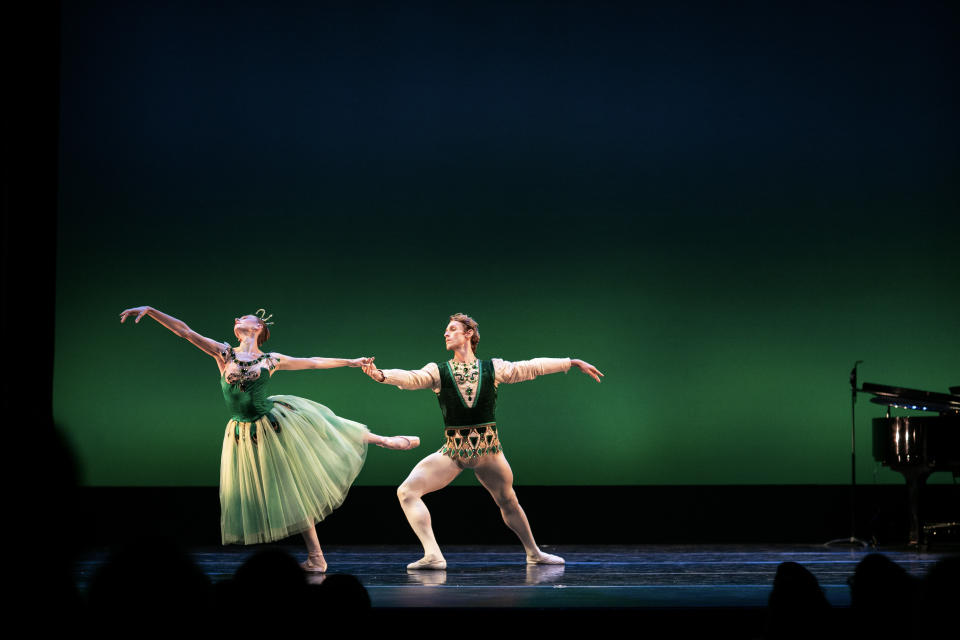
New Audiences
“We’re really looking for other audiences. We certainly know we have our classic, older audience, but more and more now younger people walk through the doors,” Grover says, citing the Guild Hall Teen Arts Council of 20 teenagers who live locally, are paid staff members, help curate public programming, handle workshops with professional artists, and can advance their own creative ambitions. “The intention of this renovation is really to expand it to everyone in the community and be more like the library across the street that everyone uses and thinks of as theirs.”
Guild Hall also has a “Creative Lab” classroom where guest artists teach, and an “Academy of the Arts,” which is an honorific body of artists, performers, writers, designers, thought leaders, all living in the community and connected to Guild Hall through programming, curating exhibitions, or performing. “It’s kind of like the core of artists we work with. There about 210 Academy members. We’re like a sandbox for them,” Grover says. Among the members: guitarist G.E. Smith, food critic Florence Fabricant, designers Betsey Johnson and Ralph Lauren, and most recently, Fern Mallis, fashion doyenne and former head of New York Fashion Week.
“Guild Hall,” observes board member Schultz, putting it succinctly, “is like a little institution with a big history.”
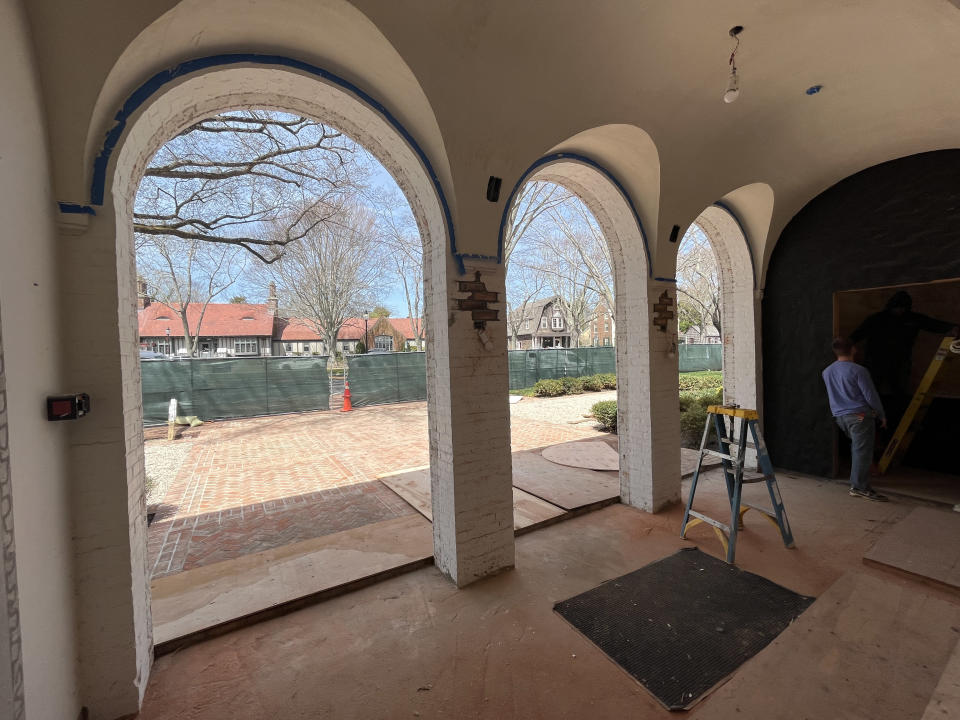
Architects on the Project
For its $30 million renovation, Guild Hall’s interior and exterior design plans were drawn up in 2021 and work began in July 2022. From 2004 to 2009 there were some renovations at the site, but more of a cosmetic nature and not of the comprehensive character of the current project.
“Our firm renovated and altered the entire building including the entrance portico, the lobby, galleries, education center, John Drew Theater and support spaces,” says Peter Pennoyer of Pennoyer Architects. “We opened the building to the street by exposing the original loggia, which had been closed behind aluminum doors. Our renovation transforms interiors that were quite domestic and, in some cases, cramped to create open, well-lit following spaces with increased wall area for art. We restored an original indirect skylight that appears in the vaulted ceilings of galleries.
“The theater was hampered by a center aisle, small boxes, columns that fell in the sight lines and a control booth open to the orchestra seating. We transformed the theater by centering the seating, opening the original proscenium frame and restoring many original details, while simplifying others.”
He characterizes Guild Hall’s architecture as typical of the light classicism of the architect Aymar Embury who built Guild Hall. “The building serves as a gateway to the village,” he says.
“When looking at the landscape for Guild Hall, we wanted to think about it’s importance as part of the fabric of East Hampton as well as creating spaces that work for the those associated with the activities produced by Guild Hall,” says Edmund Hollander, president of Hollander Design, the landscape architects for the project. “Collaborating with Peter Pennoyer and his team one of our first goals was to rethink the front entry so that it provided a welcoming area for gatherings as well as contributing to the public life of the sidewalk in front of Guild Hall. New stone dust seating areas were designed to accommodate café tables and chairs as well as a new main walkway. Existing lawn areas that were ecologically detrimental were replaced with native fescue grasses that create a soft pillow meadow feeling while contributing to a pollinator, friendly toxin free landscape.
“The Minikes garden we designed previously is anchored by four trees set within the frame of classic Hampton’s white hydrangea. This makes the perfect space for pre-theater or post theater, cocktails and other events. The Furman garden was reimagined as a public gathering space that would allow any number of different activities and performances.”
Hollander says with collaboration with Guild Hall and Pennoyer, his team created a series of spaces “inviting artistic expression and performances outside as well as inside the building in a landscape of ecological appropriateness and sustainability.”
Best of WWD

